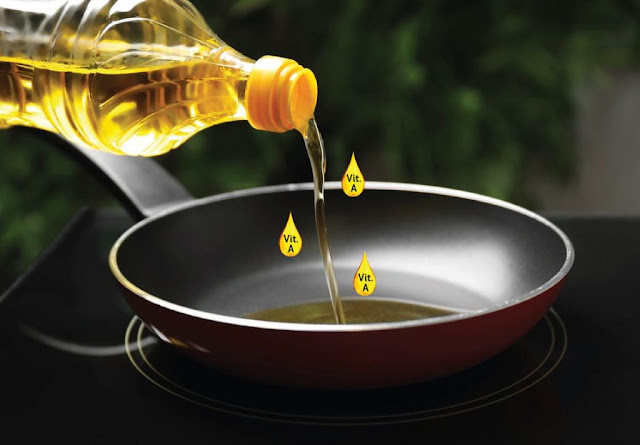Cooking Oil
Cooking Oil
Cooking oil are a kitchen staple. Nowadays everyone is cautious about which food to consume for maintaining a healthy heart and overall wellness. Every household basic ingredient is the oil used in Indian cuisine.
Oils are all packed with fat and calories, but their chemistry and effect on our health can be very different. How much oil an individual can take? It is recommended that 20 gram or 4 teaspoonful of oil for an adult is recommended per day for our day to day busy schedule. Earlier our parents and grand parents, we all have seen, how all varieties of food products were prepared at home, but now we have become lazy or it is readily available in the market, so we are at least concern of taking effort at home to prepare.
"The least amount of oil we use it is better."
Introduction
Cooking oil is plant, animal, or synthetic fat used in frying, baking, and other types of cooking. It is also used in food preparation and flavoring not involving heat, such as salad dressings and bread dipping like bread dips, and may be called edible oil.
We Indians love fried food items. When some guest visit homes, while watching movies specially or during tea time. When we heat oil for frying, oils are decomposed or breakdown the oil producing cancerous substances. So the best oil for frying is the oil that can withstand high temperatures without foaming or smoking are good for frying.
Based on our present lifestyle, habit and diet we all consume a substantial amount of invisible fat, like dairy products, biscuits, nuts, grated coconut and if we are non-vegetarians then we consume fish, meat, eggs as our diet already contains fats, so it is better to take less amount of oil, any added oil will always turn out to be excess in our diet.
"Change your cooking oil every three months."
Sesame Oil
Effect on doshas : Perturbs pitta and kapha.
Other effects in bodies : Best among vata relieving agents.Constipation ,reduces urine, output, promotes strength,, intellect by processing with medicinal plant, counters all diseases.
Mustard Oil
Qualities : Pungent ,hot
Effect on doshas : Disturbs rakta and pitta. Diminishes kapha and vata.
Other effects in bodies : Relieves itching and skin rashes, reduces semen.
Flax/Linseed seed Oil
 |
| Flax Seed Oil |
Qualities : Sweet,sour Katu, Post digestive effect hot.
Effect on doshas : Relieves vata disorders, perturbs rakta and pitta.
Ground Nut Oil
Oil Extraction
Around 500 BC In India oil was obtained through oil press. During 1500 BC using mortar and pestle or grinding on a flat stone was used for pressing of crushing of oil seeds . And the process of extracting oil by this method was called as Ghani or the kolhu or chekku. This tradition system of extracting oil was also seen in Afghanistan, Sri Lanka Myanmar and Greece.
Manufacturing and Processing of Oil
In the current market we find various brands of refined oils that are manufactured through an intensive mechanical and chemical process. Cooking oil are pure fat obtained from plants and animals. When we consume 1 gram of cooking oil , it is equivalent to nine calories.
Trans fat are basically two kinds :
- Natural Trans fat can be found in the gut of an animals that graze on grasses. There four some amount of Trans fat are found in products like meat, meat products, milk and milk products. In this product the level of trans fat could be as low as 2.5% of fat content.
- Second type of trans fat is formed artificially when hydrogen is added to vegetable oil in a process called hydrogenation. This process makes vegetable oil solid like vanaspati.
Depending upon several factors the trans fat level in vanaspati could be as high as 50-60% of the total trans fat content.
Food manufacturers add hydrogen to liquid vegetable oil and heat them. The process hardens the oil and increases shelf life. Food made with such partially hydrogenated fats has better texture, flavor and taste and spread ability. Consuming these oils is linked to Diabetes, cancer and also heart disease.While these oils are quite toxic resulting in blood inflammation, the elevation of triglycerides and worsen insulin secretion.
Foods prepared in restaurants, takeaways, flight / railway kitchens, street side stalls, dhabha and halwais, do you know which oil they use? Most of them use vanaspati. Which is a trans fat, which is loved by all processed food industry in the market. The trans fat are used in breakfast cereals, bread spread, biscuits, crackers, cookies, rusk, breads, cake mix. Microwave pop corn, pizza, burger and french fries, ready to eat foods. If trans fat makes food so tasty , why are they so bad?
Trans fat foul up the body's entire machinery. They increase LDL cholesterol which clogs up arteries
and lower the HDL cholesterol, which would otherwise take HDL cholesterol to the liver where it would be broken down and excreted. Trans fat interferes with the metabolism of fats and elevates blood triglycerides levels. If one continues to eat trans fats rich foods, it set the stage of a heart attack. Also trans fat found naturally in animal fats is much less harmful than that found in hydrogenated oils.
When you buy a product next time please read the nutritional fact on the label and see the amount of trans fat used than decide to take it to the same cookies/ bread/cake can be made at home itself.
In the market edible oil are of two types, like cold press oil and hot press oil. Cold press oil is also called virgin oil. The difference between the two is : In cold press oil seeds are pressed in low temperature and the acid value is relatively low and oil is obtained after precipitation and filtration. And also seeds are pressed without roasting. Where as in hot pressed oil the seeds are roasted and pressed under very high temperature, the acid value rise. So the crude oil can be edible only after refining.
Cold Press Oil
Oils are having natural properties, original taste and flavors are retained.
Cold pressed oil after heating for deep frying will not foam or silt.Used for salad dressings, flavoring or low temperature cooking such as sauteing.
Cold pressed oil is squeezed below 60 degree C. Some oil seeds such as coconut, flax seed and olive seeds are suitable for that.
Hot Press Oil
In hot press oil the process of heating destruct the plant cells, denature the protein, reduce oil viscosity, and improve the yield efficiency. The bio active substance in the oil such as vit E, sterol, caritinoid will endure a massive loss.
Hot pressed oil after deep frying foam slit.
Hot pressed oil mashed materials are than heated to 100-120 degree centigrate in so called cooker in the hot oil processing.
Every one of us like to choose oils that are healthy, balanced and we can stay healthy, balanced and we can stay healthy even after cooking. The stability of oil greatly determines how good the oil for cooking at a high temperature and does not go rancid easily. Refined cooking oils undergo oxidation, it reacts with oxygen to form free radicles, which are harmful to health. Furthermost, different oils have varing amounts of fats -Polyunsaturated, Monounsaturated and Saturated fats.
https://madhuchhandacdmo.blogspot.com/2021/03/cooking-oil.html











Comments
Post a Comment